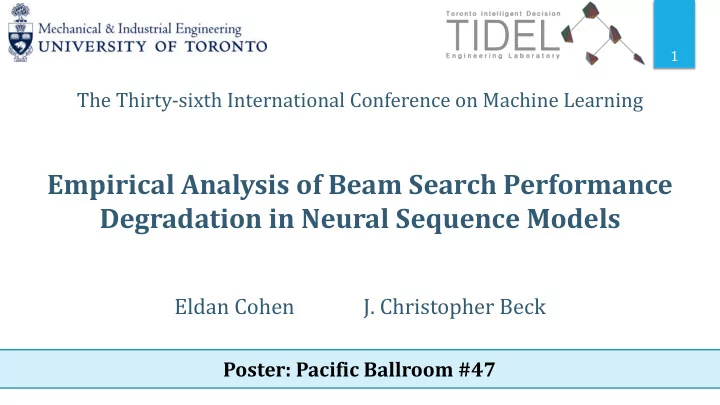

1 The Thirty-sixth International Conference on Machine Learning Empirical Analysis of Beam Search Performance Degradation in Neural Sequence Models Eldan Cohen J. Christopher Beck Poster: Pacific Ballroom #47
Motivation 2 u Most commonly used inference algorithm for neural sequence decoding u Intuitively, increasing beam width should lead to better solutions u In practice, performance degradation for larger beams u While the search finds solutions that are more probable, they tend to have lower evaluation u One of six main challenges in machine translation (Koehn & Knowles, 2017)
Beam Search Performance Degradation 3 Task Dataset Metric B =1 B =3 B =5 B =25 B =100 B =250 Translation En-De BLEU4 25.27 26.00 26.11 25.11 23.09 21.38 En-Fr BLEU4 40.15 40.77 40.83 40.52 38.64 35.03 Summarization Gigaword R-1 F 33.56 34.22 34.16 34.01 33.67 33.23 Captioning MSCOCO BLEU4 29.66 32.36 31.96 30.04 29.87 29.79 u Different tasks: translation, summarization, image captioning u Previous works highlighted potential explanations: u Machine translation: source copies (Ott et al., 2018) u Image captioning: training set predictions (Vinyals et al., 2017)
Analytical Framework: Search Discrepancies 4 u Inspired by search discrepancies in combinatorial search (Harvey & Ginsberg, 1995) u Search discrepancy at sequence position t logP θ ( y t | x ; { y 0 , ..., y t − 1 } ) < max y ∈ V logP θ ( y | x ; { y 0 , ..., y t − 1 } ) . ratio between the most probable token and the chosen token as discrepancy u Discrepancy gap for position t max y ∈ V log P θ ( y | x ; { y 0 , ..., y t − 1 } ) � log P θ ( y t | x ; { y 0 , ..., y t − 1 } ) .
Empirical Analysis (WMT’14 En-De) 5 Search discrepancies vs. sequence position • Increasing the beam width leads to more, early discrepancies • For larger beam widths, these discrepancies are more likely to be associated with degraded solutions
Empirical Analysis (WMT’14 En-De) 6 Discrepancy gap vs. sequence position • As we increase the beam width, the gap of early discrepancies in degraded solutions grows
Discrepancy-Constrained Beam Search 7 <sos> comment vas [-0.69] est [-0.92] venu [-2.99] ... ≤ 𝓝 Discrepancy gap: 0 0.23 2.30 … ≤ 𝓞 Candidate rank: 1 2 3 … • M and N are hyper-parameters, tuned on a held-out validation set. • The methods successfully eliminate the performance degradation
Summary 8 u Analytical framework based on search discrepancies u Performance degradation is associated with early large search discrepancies u Propose two heuristics based on constraining the search discrepancies u Successfully eliminate the performance degradation. u In the paper: u Detailed analysis of the search discrepancies u Our results generalize previous observations on copies (Ott et al., 2018) and training set predictions (Vinyals et al., 2017) u Discussion on the biases that can explain the observed patterns
9 The Thirty-sixth International Conference on Machine Learning Empirical Analysis of Beam Search Performance Degradation in Neural Sequence Models Eldan Cohen J. Christopher Beck Poster: Pacific Ballroom #47
Recommend
More recommend